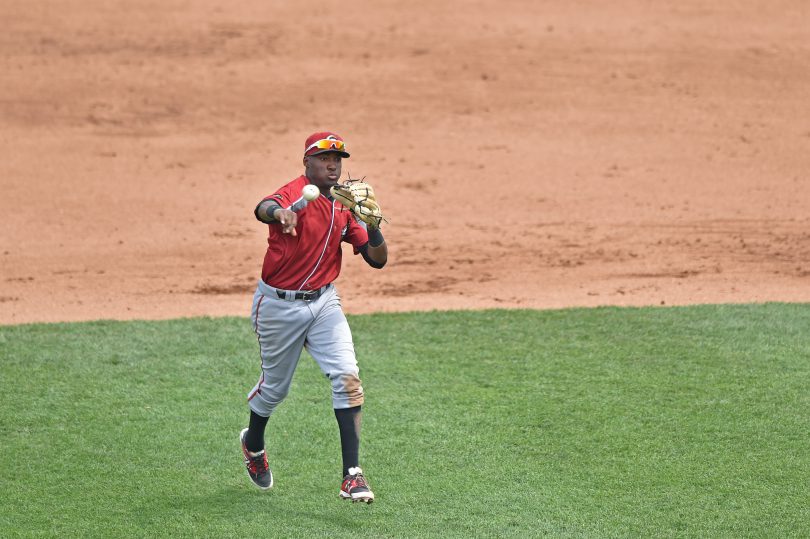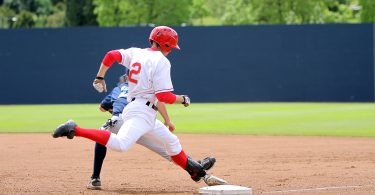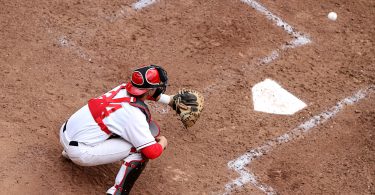The Situation:
It’s the top of the second inning of a playoff game. The score is 1-1 and the offense is threatening to open up a lead. There are runners on first and second with two outs, with a full count on the batter. The right-handed 9-hole hitter, known to be in the game for his defensive prowess is up to bat. He is hitting a paltry .158 on the season and should get a pitch in the zone.
The Play:
The pitcher delivers a fastball on the outside corner and batter swings around the ball, chopping it into the ground with weak contact. To the batter’s delight, it’s a perfectly placed swinging bunt that trickles down the third base line. The third baseman charges hard and makes the barehanded play on the run. He glances up to see the batter already approaching first and knows it will take a full force throw to have even the slimmest of chances to throw him out. The third baseman wings the ball as hard as he can to the first baseman. He hooks the throw to the second base side. The first baseman stretches out, coming off the bag to try to snag the wild throw. He gets his glove on the ball but the throw is too hard and too wide. It tips off the top of the first baseman’s mitt and rolls away from him towards the outfield grass.
The Outcome:
By the time the first baseman gathers the ball, the runner from second has already scored easily. The runner from first base is streaking towards third, and the first baseman wings the ball across the diamond. The runner dives in head first ahead of the bouncing throw. The batter stays at first base, leaving runners at the corners with 2 outs. The next batter flies out to the center fielder, ending the threat. The damage could have been worse, but the lead has been regained heading to the bottom of the second.
What Went Wrong:
The swinging bunt is one of those plays that remind players why baseball can be so tough on the psyche. The pitcher made a great pitch and ‘beat’ the batter, but the lucky result favors the batter, who collects a base hit. In baseball, if you work the process well (do everything in your power correctly) and the results don’t go your way, you can live with it because you understand that over time, if your process is right, things will go your way more often than not. What is tough to live with is the third baseman’s mental mistake of trying to force the throw on an incredibly low percentage, difficult play.
There are several important circumstances that should factor into the decision-making of the third baseman on this play:
1) A running barehanded play is one of the most difficult plays a third baseman can be asked to make.
2) There are 2 outs and a 3-2 count, meaning the runners will be moving on the pitch.
3) On a hard charging play like this, the third baseman is blind to the lead runner who is running on the pitch and will have an excellent jump towards home.
4) Since the third baseman has vacated the bag to field the ball, there is no one left to immediately cover third base. This allows the runner from second to make an aggressive turn and if the shortstop does not make it over to cover third, will also allow him to extend almost as far as the nearest defender (likely the shortstop or third baseman).
5) How long does it take the third baseman to get to the ball?
6) What is the speed of the batter and runners?
It may seem like a lot to know in a split second, but the third baseman is expected to be aware of all 6 of these things during the time it takes him to get to the ball. Given where the batter runner is when he collects the ball (which he should have guessed before he looks up, given his pre-play knowledge of number 6 and knowledge of 5 as the play develops), the third baseman should know that there is a very slim chance to make the play. As such, the third baseman must err on the side of caution and hold on to the ball. The best play here would be a pump fake to first base and a quick turn to try to catch the lead runner being too aggressive rounding third. Worst-case scenario, no runs score and you still have 2 outs.
It’s not just that the third baseman made a poor throw, the decision to make the throw on a ‘blind’ play where the risks overwhelmingly outweigh the reward is also a problem. Even if the throw was on target, there was little chance the batter would have been out. There is a better chance that even if the throw was accurate, the runner from second, moving on the pitch and with no one at 3rd to slow his momentum, would have been able to keep going and score on the play. There was a similar play to this in game 5 of the 2015 World Series when Eric Hosmer scored on a play where the third baseman was forced to vacate the bag to make a play, allowing Hosmer the opportunity to gain momentum and distance towards home as the play developed.
There really is only one play for the third baseman to make here, and that’s to hold the ball. Now that you have had time to think the game, click here to see the play and decide for yourself. It happened in game 4 of the 2016 World Series!







